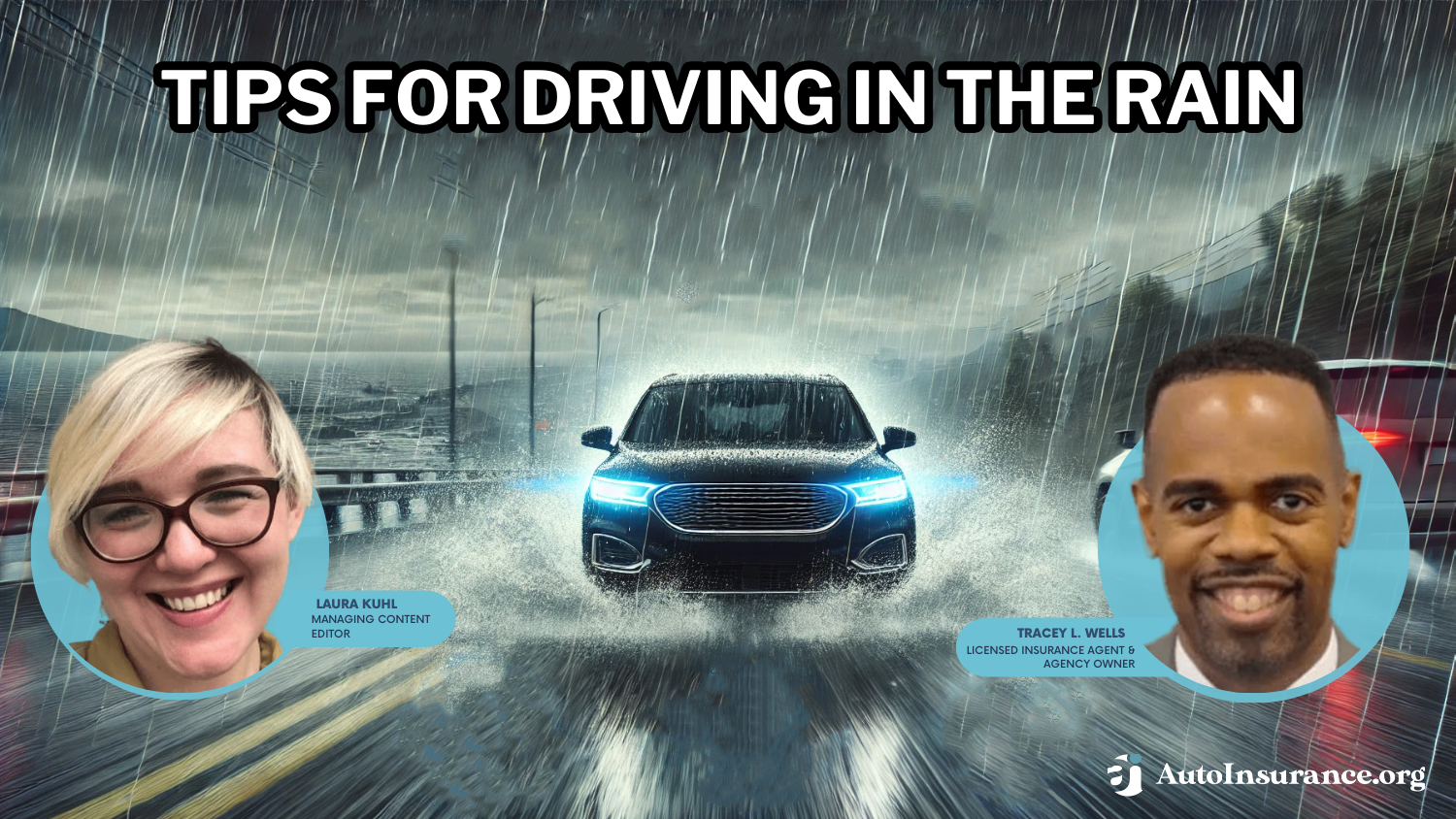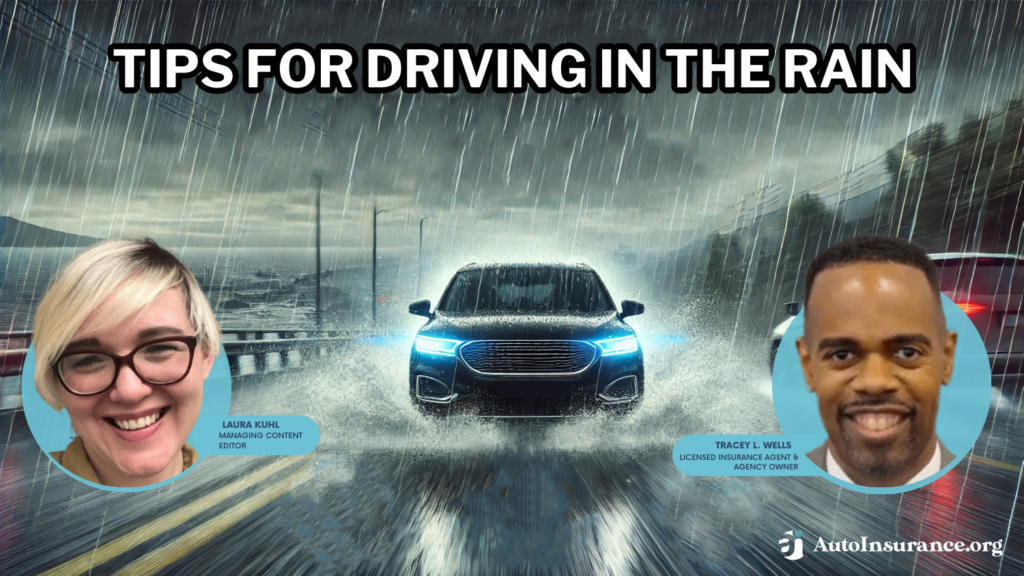Tips for Driving in the Rain (2025)
Driving in the rain can be a source of anxiety for new and seasoned drivers, alike. Whether it's wet, slippery roads or the inability to see clearly in front of you, following safety tips for driving in the rain can prevent a dangerous situation. Make sure to prepare for wet conditions and drive slower to avoid skidding or hydroplaning.
Read moreFree Car Insurance Comparison
Compare Quotes From Top Companies and Save
Secured with SHA-256 Encryption

Tracey L. Wells
Licensed Insurance Agent & Agency Owner
Tracey L. Wells is a licensed insurance agent and Farmers insurance agency owner with 23 years of experience. He is proud to be a local Farmers agent serving Grayson, Georgia and surrounding areas. With experience as both an underwriter and agent, he provides his customers with insight that others agents may not have. His agency offers all lines of insurance including home, life, auto, RV, busi...
Licensed Insurance Agent & Agency Owner
UPDATED: Oct 24, 2024
It’s all about you. We want to help you make the right coverage choices.
Advertiser Disclosure: We strive to help you make confident auto insurance decisions. Comparison shopping should be easy. We are not affiliated with any one auto insurance provider and cannot guarantee quotes from any single provider. Our partnerships don’t influence our content. Our opinions are our own. To compare quotes from many different companies please enter your ZIP code on this page to use the free quote tool. The more quotes you compare, the more chances to save.
Editorial Guidelines: We are a free online resource for anyone interested in learning more about auto insurance. Our goal is to be an objective, third-party resource for everything auto insurance related. We update our site regularly, and all content is reviewed by auto insurance experts.
UPDATED: Oct 24, 2024
It’s all about you. We want to help you make the right coverage choices.
Advertiser Disclosure: We strive to help you make confident auto insurance decisions. Comparison shopping should be easy. We are not affiliated with any one auto insurance provider and cannot guarantee quotes from any single provider. Our partnerships don’t influence our content. Our opinions are our own. To compare quotes from many different companies please enter your ZIP code on this page to use the free quote tool. The more quotes you compare, the more chances to save.
On This Page
If you’re new to driving or new to a rainy area, you might be wary of getting behind the wheel. By following a few safety and defensive driving tips, you’ll be a safer driver and feel confident in your driving abilities and comfortable in the car.

If you’re looking to refresh your memory on best practices, here are some tips for driving in the rain.
- Use your headlights and windshield wipers to increase visibility
- Lower your speed and increase the distance between you and the vehicle in front of you
- Be wary of standing water to avoid hydroplaning
1. Prepare in Advance
Check the weather conditions and forecast when planning your trip. If you’re not comfortable driving in the rain, can you delay your errands until after the weather improves? A little planning goes a long way in avoiding suboptimal driving conditions, and it’s always safer to avoid inclement weather whenever possible.
But sometimes, driving in rainy conditions is unavoidable. So, what then? How can you best prepare for the wet road conditions?
The best preparation for safely driving in wet weather is keeping your vehicle’s equipment up-to-date:
- Always ensure your tires’ treads are in good condition.
- Check that your headlights, taillights, and windshield wipers are working well to ensure you’re driving safely and legally. If your wipers are making noise or leaving marks as they pass over your windshield, it might be time to replace them.
- Stay up to date with vehicle recall check appointments and brake checks, including anti-lock braking systems.
Free Auto Insurance Comparison
Enter your ZIP code below to view companies that have cheap auto insurance rates.
Secured with SHA-256 Encryption
2. Maximize Your Visibility
The first thing to do in rainy weather is to ensure that your visibility will be as clear as possible — for you and the other drivers. Make sure you can see what’s in front of and behind you and that drivers can easily see your car on the road. Begin by turning your headlights and windshield wipers on. This way, others can see you approaching from farther away, and you can see them more easily, too.
Ensure that your vehicle is well-ventilated. Condensation on the inside of your vehicle can also reduce your visibility by obstructing your view out the front or side windows. To quickly defog your windows, try:
- Using your car’s defroster
- Turning on your car’s heat, then your car’s A/C to remove moisture from the air
- Turning off the air circulation system, which brings cold, wet air into your car
- Cracking a window or two, if necessary
If you’re unable to clear your view enough to safely continue driving, pull over and wait for your windows to defog.
3. Brake Earlier and Drive Slower
When conditions are wet, everything takes a little longer as you drive. Even if your reaction times are just as quick, your vehicle’s responsiveness won’t be. Rainwater decreases the friction between your tires and the road, so braking will take longer than you’re used to in dry weather.
Therefore, you’ll want to drive slower than you usually would and maintain a greater following distance between yourself and the vehicle in front of you. In normal conditions, driving teachers recommend following three seconds behind the car in front of you — with slick roads that should be closer to four.
Give yourself longer for braking, as well, by easing off the accelerator and slowly pressing the brakes long before you reach the line of idle cars at a stoplight, for example.
4. Pay Attention to Potential Hazards
There are a couple of dangers that come with driving in heavy rain. You’ll want to look out for these potential hazards and prepare accordingly:
Poor Visibility
Drivers have an impaired ability to see each other in heavy rain, especially during a heavy downpour. Be aware of your limitations and try not to assume others can see you as they would otherwise, even if you can see them. The same applies to the lines on the road — avoid close proximity to other cars, especially around corners, in case they swerve between lines.
Delayed Reaction Time
Your brakes and tires won’t behave as well as they do in clear conditions, and the same goes for the brakes of every vehicle on the wet road. Drive cautiously, with the knowledge that a sudden swerve or a slam of the brakes might not be possible as a defensive driving technique.
Hydroplaning
Hydroplaning occurs when a layer of water forms between your vehicle’s tires and the wet road. Due to a lack of friction, your vehicle might slip or skid out of control. To avoid this occurrence, be wary of deep puddles of water. If you find yourself in a situation where your vehicle is hydroplaning, try not to panic. Instead of slamming on the brakes or overcorrecting, gently take your foot off of the accelerator and steer in the desired direction.
Free Auto Insurance Comparison
Enter your ZIP code below to view companies that have cheap auto insurance rates.
Secured with SHA-256 Encryption
Protect Yourself in All Situations With Auto Insurance
Due to limited visibility and slick roads, accidents tend to happen more often during periods of inclement weather — rain more so than any other condition. Thankfully, auto insurance covers damages incurred during accidents, so long as the driver took the necessary precautions to drive safely on the wet roads.
Keep these safety tips in mind and check out autoinsurance.org for the best prices on car insurance, and you’ll be more than ready for the next bout of rainy weather.
Frequently Asked Questions
Why is it important to drive slower in wet weather?
Driving slower in wet weather is important because rainwater reduces the friction between your tires and the road, making it harder to stop quickly. Slower speeds give you more time to react to potential hazards.
What is hydroplaning, and how can it be avoided?
Hydroplaning occurs when a layer of water forms between your vehicle’s tires and the wet road, causing loss of control. To avoid hydroplaning, be cautious of deep puddles and reduce your speed. If hydroplaning does occur, gently take your foot off the accelerator and steer in the desired direction.
Does auto insurance cover damages caused by accidents in rainy weather?
Yes, auto insurance typically covers damages incurred during accidents, including those that happen in rainy weather. However, it’s important to take necessary precautions and drive safely on wet roads.
How can I maximize visibility while driving in the rain?
To maximize visibility, turn on your headlights and windshield wipers. This ensures that you can see the road clearly and that other drivers can see you. Additionally, keep your vehicle well-ventilated to prevent condensation from obstructing your view.
Can I delay my errands if I’m not comfortable driving in the rain?
Yes, if you’re not comfortable driving in the rain, it’s safer to delay your errands until the weather improves. Checking the weather conditions and forecast in advance allows you to plan your trips accordingly and avoid suboptimal driving conditions.
Free Auto Insurance Comparison
Enter your ZIP code below to view companies that have cheap auto insurance rates.
Secured with SHA-256 Encryption
Tracey L. Wells
Licensed Insurance Agent & Agency Owner
Tracey L. Wells is a licensed insurance agent and Farmers insurance agency owner with 23 years of experience. He is proud to be a local Farmers agent serving Grayson, Georgia and surrounding areas. With experience as both an underwriter and agent, he provides his customers with insight that others agents may not have. His agency offers all lines of insurance including home, life, auto, RV, busi...
Licensed Insurance Agent & Agency Owner
Editorial Guidelines: We are a free online resource for anyone interested in learning more about auto insurance. Our goal is to be an objective, third-party resource for everything auto insurance related. We update our site regularly, and all content is reviewed by auto insurance experts.
